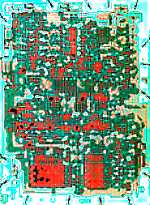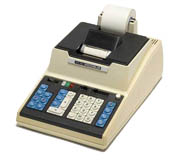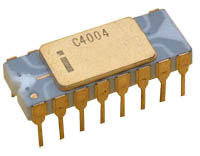The First Microprocessor
The First Microprocessor - Intel's Beginning
 Intel was founded on July 18, 1968 by Robert Noyce, Gordon Moore, and Andrew Grove. At the time the trio had a very specific goal of making semiconductor memory practical and affordable. Intel was founded on July 18, 1968 by Robert Noyce, Gordon Moore, and Andrew Grove. At the time the trio had a very specific goal of making semiconductor memory practical and affordable.
See silicon chip memory was literally around 100 times more expensive than the more common magnetic memory used at the time. Robert Noyce felt that all they had to pull off to capture the market was to reduce the cost by nearly a factor of one hundred. Well that is exactly what they set out to do.
Within 2 years Intel was a very successful memory chip manufacturer who in fact introduced the whopping 1Kb memory chip which was actually larger than anything else at the time. While it wasn’t much compared to today’s standards, the chip stored 128 bytes of memory and it was known as the 1103 dynamic random access memory (DRAM). In fact this chip became the world’s largest selling semiconductor by the end of the next year. Another milestone for Intel at the time was that the company also grew to more than 100 employees.
Intel’s success in the memory market drew in a business proposal from a Japanese manufacturer named Busicom who asked Intel to design various chips for high-performance programmable calculators. Busicom however wanted around 12 custom chips which Intel engineer Ted Hoff rejected because it simply wasn’t practical. Instead he designed a single chip general purpose logic device which fetched its application instructions from semiconductor memory.
 Because it was general purpose the CPU could actually be used in devices other than calculators. Specific tasks could be performed via simple control by a program. See previous designs were wired for one purpose with already built in instructions. Because it was general purpose the CPU could actually be used in devices other than calculators. Specific tasks could be performed via simple control by a program. See previous designs were wired for one purpose with already built in instructions.
Hoff wanted his design to be able to perform numerous functions depending on the instructions it was given instead of it being limited to a single purpose via simple built in instructions.
Of course while all is going well, there was unfortunately one problem with the new chip. Busicom actually owned the rights to it and Intel designers including Hoff knew the chip had near limitless application. They couldn’t just let something revolutionary go.
Intel finally ended up repurchasing the rights to the product despite concerns that the chip would distract them from their main focus of manufacturing memory. See Intel was finally convinced that each microcomputer was worth the investment because it still included two memory chips in its four chip design. This then of course actually ended up being beneficial due to the fact that they were still going to sell two memory chips with it due to its 4 chip nature.
Intel decided to return Busicom’s original 60,000 dollar investment for the rights to the product. Busicom happily agreed due to financial troubles. The significance of the deal though unknown at the time was unbelievable and directly responsible for Intel becoming the leader in processors today. Oh how history could have been different if it wasn‘t for the brainchild’s at Intel and their decision to repurchase their amazing product.
The First Microprocessor - Intel 4004
 Finally in November of 1971 Intel publicly introduced the world's first single chip microprocessor called the Intel 4004. It was invented by Intel engineers Ted Hoff, Federico Faggin, and Stan Mazor. Finally in November of 1971 Intel publicly introduced the world's first single chip microprocessor called the Intel 4004. It was invented by Intel engineers Ted Hoff, Federico Faggin, and Stan Mazor.
The Intel 4004 was smaller than a thumbnail, packed 2,300 transistors, executed 60,000 operations a second, and sold for $200 at the time.
But the most amazing part of the first microprocessor was the fact that it actually delivered as much computing power as the entire first electronic computer, ENIAC.
Simply amazing! And let's not forget the beginning of a revolution, way to go Intel.
Return to:
Return
from The First Microprocessor to Home Page
Contact us | View site map
|